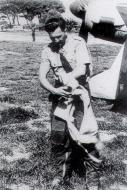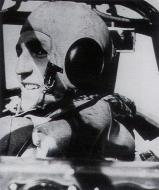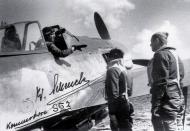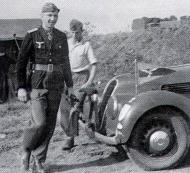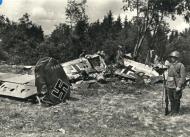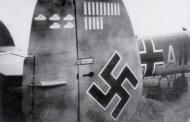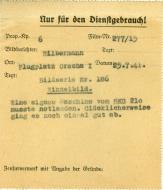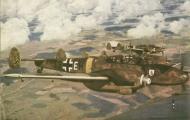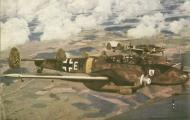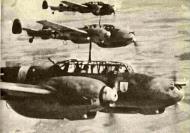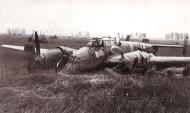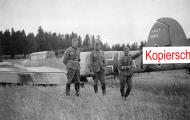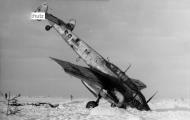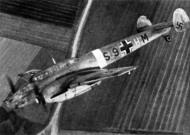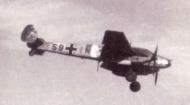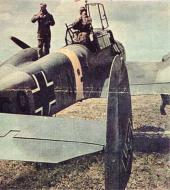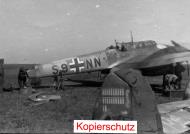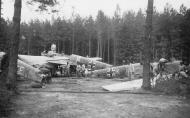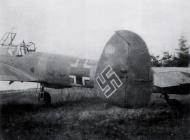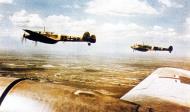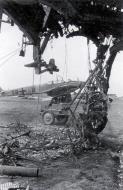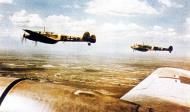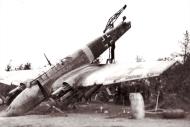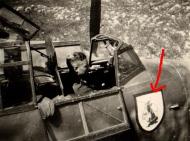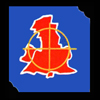
Stab I. Gruppe Schnellkampfgeschwader 210 - Stab I./SKG210
Stab I. Gruppe Schnellkampfgeschwader 210 - Stab I./SKG210
Messerschmitt Bf 110E Zerstörer Stab I./SKG210 (S9+AB) Russia 01
Photo 01: In-flight view of S9+AB and S9+CB of the Gruppenstab of I./SKG210. Note that both aircraft have the yellow theatre band. S9+AB has the revised tail wheel with the small scissors link.
Messerschmitt Bf 110E Zerstörer Stab I./SKG210 (S9+BB) Russia 01
Photo 01: Bf 110E, S9+BB, of the Gruppenadjutant of I./SKG2l0. A yellow Russian theatre band can be seen aft of the wing root. The early style fuselage cross is carried, a feature of many I./SKG 210 aircraft. The individual aircraft letter 'B' is in the Gruppenstab colour of green with a thin black outline. The Bordfunker's rear central canopy panel has been removed, a practice that originated with the unit's predecessor, Erprobungsgruppe 210.
Messerschmitt Bf 110E Zerstörer Stab I./SKG210 (S9+CB) Russia 01
Photo 01: In-flight view of S9+AB and S9+CB of the Gruppenstab of I./SKG210. Note that both aircraft have the yellow theatre band. S9+AB has the revised tail wheel with the small scissors link.
1 Staffel I. Gruppe Erprobungsgruppe 210 - 1./SKG210
Messerschmitt Bf 110E 1./SKG210 (S9+GK) pilot Wolfgang Schenck Seschtschinskaja, Russia Sep 1941 01
Photo 01: Bf 110E, S9+AR, of Oblt. Wolfgang Schenck, Staffelkapitänof 1./SKG210which became I./SKG210, seen at Seschtschinskaja in September 1941. The yellow Russian theatre band can just be seen ahead of the letter 'R' of the fuselage code. The individual aircraft letter 'A' is white with a thin black outline. The fuselage cross is a reversion to the earliest style used. The rudder shows the destruction of five Russian tanks, and the fin shows a total of 15 victory bars.
Aircrew Luftwaffe pilot EG210 Wolfgang Schenck 1940 01
Photo 01: Wolfgang Schenck in the cockpit of a Bf 110. Schenck flew in the Polish and Western campaigns, being wounded on 16 May. He returned to flying on 4 September with I./Erpr.Gr.210. He then flew on the Russian front with SKG210 and ZG1, and later led the development of the Me-262 as a fighter bomber as head of 'Kommando Schenck' in mid 1944. His last flying duty was as Geschwader kommodore of KG51 flying Me-262s. He was a recipient of the Knight's Cross with Oakleaves.
Aircrew Luftwaffe pilots SKG210 Wolfgang Schenck 194 01
Photo's 01-02: Two views of Hptm. Wolfgang Schenck at discussions about a forthcoming mission. The Knights Cross around his neck would date the photographs as post-14 August 1941. Note the cloth SKG210 emblem on the left breast of his jacket.
Aircrew Luftwaffe pilots SKG210 Wolfgang Schenck 194 03
Photo 03: Wolfgang Schenck, facing camera, is greeted alongside a staff car.
Aircrew Luftwaffe pilots SKG210 Wolfgang Schenck 194 04-05
Photo's 04-05: Two views of Wolfgang Schenck about to board a staff car. Note the emblems of SKG210 and ZG1 on the mudguard.
Aircrew Luftwaffe pilot SG2 Wolfgang Schenck 01
Photo 01: Wolfgang Schenck, Geschwader kommodore of SG 2, gives instructions to two of his pilots from the cockpit of his Fw-190.The writing on the photograph is in Schenck's own hand.
Aircrew Luftwaffe pilot SG2 Wolfgang Schenck 02
Photo 02: 7 Wolfgang Schenck with his flying 1 overalls partly on, alongside a Fw-190
Messerschmitt Bf 110C 1./SKG210 (S9+EH) Russia 1941
Messerschmitt Bf 110C 1./Erpr.Gr.210 (S9+FH) Russia 1941Messerschmitt Bf 110E3 1./SKG210 (S9+HH) Russia 1941
Photo 01: Fitted with a rear firing canon
Messerschmitt Bf 110E 1./SKG.210 (S9+PH) Russia 1941
Photo 01: A Bf 110E-1 S9+PH, of 1./SKG210, whose pilot carried out a successful belly landing near Seschtschinskaja after receiving combat damage.
2 Staffel I. Gruppe Erprobungsgruppe 210 - 2./SKG210
Messerschmitt Bf 110C Zerstörer 2./SKG210 (S9+AK) Russia
Messerschmitt Bf 110E 2./SKG210 (S9+BK) W.Nr 4108 crash landed Seschtschinskaja 01
Photo 01: A Bf 110E-1 S9+BK, WNr. 4108, of 2./SKG210, whose pilot carried out a successful belly landing near Seschtschinskaja after receiving combat damage. The unit emblem can be seen on the forward fuselage, and the yellow Russian front theatre band is in the wing root position. Note that the Bordfunker's central rear canopy is not fitted on this machine.
II. Gruppe Schnellkampfgeschwader 210 - II./SKG210
Messerschmitt Bf 110C Zerstörer II./SKG 210 Waspe Yellow S Russia 1942
Photo's
Bf 110C-4/B 'Yellow S' of II./SKG 210, Central Sector, SW of Moscow, Winter 1941
Bf 110C Zerstorer SKG210.2 Waspe (S9+AS) Russia 1942 02Messerschmitt Bf 110 Zerstörer II./SKG210 S9+ crash landing 01
Photo 01: 2./SKG210 Bf 110 after a heavy landing. Note the letter 'A' on the engine cowling on the ground, denoting the tltment of the DB 601 A engine. The strong contrast between the two camouflage colours on the wings would indicate the application of RLM 71 and 02.
Stab II. Gruppe Schnellkampfgeschwader 210 - Stab II./SKG210
Messerschmitt Bf 110E Stab II./SKG.210 (S9+FC) Russia 1941
Photo 01: A Bf 110E-1 S9+PH, of II./SKG210, whose pilot carried out a successful belly landing after receiving combat damage Russia 1941.
4 Staffel II. Gruppe Erprobungsgruppe 210 - 4./SKG210
Messerschmitt Bf 110E Zerstörer 4./SKG210 (S9+HM) Russia 1941
Photo 01: Erprobungsgruppe 210 remained ranged against England through to April 1941, when it was incorporated into the newly constituted Schnellkampfgeschwader 210. Here, a Bf 110E S9+HM, is photographed in flight over Russia
Messerschmitt Bf 110C Zerstorer 6.SKG210 (S9+EP) Russia 01
III. Gruppe Schnellkampfgeschwader 210 - III./SKG210
Messerschmitt Bf 110C Zerstorer 8.SKG210 Waspe (S9+AS) Russia 1942 01-02
SKG210 Camouflage from Battle of Stalingrad Forum by 1./ZG1_Panzerbar
Ok, in short:
I./SKG210 had mainly Bf110E during 1941, and most of them were 02/71/65 without any additions to camouflage. There were two little bit different mottle schemes (depended on factory - Mtt or Gotha). In october 1941, I./SKG210 flew back from the front to be equipped with Me210. Only 2./SKG210 stood at the Moskow front to late december. Staffel was attached to II./SKG210, and it was first time I Gruppe's aircraft got 'large wespe' emblem (II Gruppe got it early in spring 1941). There is no evidence of winter camouflage of I./SKG210 ever seen by me. In january 1942, I./SKG210 was renamed in I./ZG1, and was equipped with Bf110F-4' (74/75/76) and some older variants. Old crows, that came from overhowling facilities, were largely repainted in 74/75/76. Almost all of Gruppe's Bf110 got unique 'spotted' camouflage - RLM74 spots and mottle over basic camo. Emblems - two main versions of wasp + modified SKG210 schield.
II./SKG210 operated some Bf110E's, but mainly with D's, painted with 02/71/65. Emblems - mainly 'large wasp', in two little different styles.
During Battle of Moskow, Bf110's were camouflated with winter paint. In January 1942, when Gruppe became II./ZG1, appeared interesting feature - aircraft code was overpainted exept 1 letter aft the Balken Kreuz, so, for example, S9+SM became __+S_.Gruppe flew combat missions to March 1942, when was withdrown to rest and refit. AS I Gruppe, it was equipped with Bf110F-2/4, and with old crows. Almost all of them wearing 74/75/76 (but still some 02/71/65 aircrafts were seen in october 1942 over Stalingrad).
During winter 1942/43, ZG1 didnt used winter camouflage at all.
I./SKG210 had mainly Bf110E during 1941, and most of them were 02/71/65 without any additions to camouflage. There were two little bit different mottle schemes (depended on factory - Mtt or Gotha). In october 1941, I./SKG210 flew back from the front to be equipped with Me210. Only 2./SKG210 stood at the Moskow front to late december. Staffel was attached to II./SKG210, and it was first time I Gruppe's aircraft got 'large wespe' emblem (II Gruppe got it early in spring 1941). There is no evidence of winter camouflage of I./SKG210 ever seen by me. In january 1942, I./SKG210 was renamed in I./ZG1, and was equipped with Bf110F-4' (74/75/76) and some older variants. Old crows, that came from overhowling facilities, were largely repainted in 74/75/76. Almost all of Gruppe's Bf110 got unique 'spotted' camouflage - RLM74 spots and mottle over basic camo. Emblems - two main versions of wasp + modified SKG210 schield.
II./SKG210 operated some Bf110E's, but mainly with D's, painted with 02/71/65. Emblems - mainly 'large wasp', in two little different styles. During Battle of Moskow, Bf110's were camouflated with winter paint. In January 1942, when Gruppe became II./ZG1, appeared interesting feature - aircraft code was overpainted exept 1 letter aft the Balken Kreuz, so, for example, S9+SM became __+S_.
Gruppe flew combat missions to March 1942, when was withdrown to rest and refit. AS I Gruppe, it was equipped with Bf110F-2/4, and with old crows. Almost all of them wearing 74/75/76 (but still some 02/71/65 aircrafts were seen in october 1942 over Stalingrad).
During winter 1942/43, ZG1 didnt used winter camouflage at all.
Aircrew Luftwaffe WOLFGANG SCHENCK
Wolfgang Schenck, or 'Bombo' Schenck as he came to be known in Luftwaffe circles, was born on 7 February 1913 in Windhoek, German South West Africa. His father,Johannes, had moved there in 1901 and taken up farming. His mother died in 1921, and in 1923, 10 year-old Wolfgang and his sister moved back to Germany to live with family in Berlin. In his teenage years he lived in Krefeld and Kaln. In 1934 he returned to South West Africa and spent time working on a coffee plantation. However, as he already held the 'C' flying certificate for gliding, and 'A' certificate for powered flight, he decided to return to Germany to take up a flying career. He entered military service in December 1936 as an officer-cadet, and was posted to II./JG 132 'Richthofen' in Jiterbog in 1938.Through re-designations, this unit was eventually to become 1 Gruppe, Zerstörergeschwader 1 (/./ZG1, and it was with 1. Staffel of ZG1 that Wolfgang Schenck started his war service, taking part in the Polish campaign in September 1939 and the Norwegian campaign in the spring of 1940.
It was not until the Western campaign that he scored his first aerial success, on 11 May 1940. However on 16 May, in combat with nine Hurricanes, he was seriously wounded, but managed to return to base. Several months in hospital followed, and when he was fully recovered, he determined that he was going to rejoin his old Staffel. On his own initiative he established that 1./ZG 1 was now 1. Staffel, Erprobungsgruppe 210 (Erpr. Gr. 210). Accordingly, he travelled to France on 4 September and was in the crew room at Denain when EG210 returned from a mission over England. Meeting a disgruntled Oberleutnant Martin Lutz (the second Gruppenkommandeur, HjJtm. Hans von Boltenstern, had been lost over the Channel on the mission) he asked if Lutz could arrange for him to join 1./Erpr. Gr. 210. Lutz told him to leave it to him as he would make the necessary arrangements. Wolfgang Schenck's involvement with the unit was instant. With the loss of von Boltenstern, Martin Lutz became acting-Gruppenkommandeur, Obit. Werner Weymann, the acting-Adjutant moved to 1. Staffel to become acting-Staffelkapitan to fill the gap left by Lutz, and Wolfgang Schenck took up the post of Adjutant from 5 September.
From then on, matters moved at a fast pace. On 27 September Martin Lutz was lost in action,his aircraft was found to have the mysterious 'Seilbomben' control box fitted when it was examined by RAF Intelligence Officers). One of the duties of the Adjutant was to oversee the equipment on the aircraft of the unit. Seilbomben was a device whereby a reinforced steel wire trailed from a set of pulleys under the fuselage of a Bf 110, with a small weight on the end of it. In the event of the invasion of England taking place, 1. Staffel would fly slow, low-level, missions trailing the 'wire rope bombs' over power cables in the invasion area. When the invasion was cancelled, Schenck had the all the control boxes removed from the 1. Staffel's aircraft, or so he thought. At one unit reunion he recounted the details of the Seilbomben device, but was dismayed when told of the fact that Martin Lutz's aircraft still had the control box in it when it came down in England. 'I failed in my duty with that falling into British hands' he said. What Schenck did not know was that Lutz's normal aircraft had been damaged some days before he was shot down over England, so Lutz simply took a 1. Staffel Bf 110 for his own use. Schenck had the control boxes taken out of all the 1. Staffel aircraft, but had not checked the Gruppenstab Bf 110's of the unit, where the rogue 1. Staffel Bf 110 with the Seilbomben control box still in place was on charge. Schenck remembered the words of Lutz before his last flight. Shaking Schenck's hand, he commented, 'This is my last flight here.
In Denain my new 'N' is waiting [Bf 110E with armour and 90 octane up graded 'N' engine - author's note]. I will breathe free again after all when going into battle, but I will bite my arse should I end up on the end of a parachute this time: Generalfeldmarschall Albert Kesselring visited EG210 at Denain on 1 October 1940, and appointed Werner Weymann as acting Gruppenkommandeur. Schenck was appointed Staffelkapitan of 1. Staffel, and at the same time promoted to Oberleutnant.
Weymann was shot down into the English Channel on 5 October, and with 1. Staffel always taking the lead in the Gruppe's airborne formation, Schenck had gone from 'new recruit' to 'Gruppenführer' (Gruppe leader) of Erpr. Gr. 210 in just over four weeks! By the time the new Gruppenkommandeur, Major Karl-Heinz Lessmann from 11/ZG 2, was posted in on 1 November, Schenck was, in effect, the leader of Erpr. Gr. 210. So much so, in fact, that Lessmann bowed to Schenck's superior knowledge of the use of the Bf 110 as a fighter-bomber and flew as Number 2 to Schenck on all his missions with the unit.
Throughout the winter months Erpr. Gr. 210 was the only unit still ranged against England, and in 1941 missions were resumed against shipping and land-based targets. By the time the unit was re-designated I. Gruppe, Schnellkampfgeschwader 210 (SKG 210) and moved east to prepare for the attack on the Russia, Schenck had flown more than 50 fighter-bomber missions against England. Schenck continued to lead 1. Staffel once the campaign in the East opened up, and through his unstinting work with E1Pr. Gr. 210 and SKG 210, he was awarded the Ritterkreuz (Knights Cross) on 14 August 1941. There followed a short spell at Rechlin at the head of the Elprobungsstaffel Me 210, but in January 1942 he returned to his old Staffel, now 1./ZG 1. In March he was appointed Gruppenkommandeur of 1. Gruppe, ZG 1, by which time he had run up an impressive 18 aerial victories as well as claims for the destruction of enemy shipping, tanks and associated hardware in the early months of the Russian campaign.
Schenck moved to a staff position in the German Air Ministry in August 1942, but by the end of January 1943 he had been appointed Geschwaderkommodore of Schlachtgeschwader 2 and he transferred to the Mediterranean theatre and took up flying the Focke-Wulf Fw 190 in the fighter-bomber role. He had, in the meantime, been awarded the Eichenlaube (Oak leaves) to the Ritterkreuz on 30 October 1942 for his achievements in the fighter-bomber role. By 1943 the Allies were increasingly gaining the air superiority, and in December 1943 he was wounded in combat. Hospitalisation followed once again, and upon release he was appointed to the post of 'Inspizient del Schlachtjlieger'. In June 1944 Schenck was given responsibility for working up the Messerschmitt Me 262 as a fighter-bomber, and headed up the specialist unit for this purpose,'Kommando Schenck'.This led to his posting as Geschwaderkommodore of Kampfgeschwader 51 (KG 51, which unit was converting to the Me 262. His final appointment was Inspector for Jet fighters from February 1945 up to the war's end.
Wolfgang Schenck had undertaken over 400 combat missions, 40 of which had been in the Me 262. Post-war, he initially returned to South Africa and took up bush flying, clocking up over 17,000 hours flying time. Ultimately, he returned to Germany and settled in Marburg. In the 1980s and 90s he was always an honoured guest at the reunions of the Wespengeschwader. He passed away some years ago in his home town, his death going almost unnoticed among the Luftwaffe fraternity in Germany.
Wolfgang Schenck was one of the most important figures in aviation history, given his role in the development of the fighter-bomber under operational conditions, as well as his initial pioneering work in the use of the Me 262 in the same role. Today, the jet fighter-bomber is the major strike aircraft in the inventory of every air force in the world. Schenck's place in history is assured.
Luftwaffe pilot Walter Nowotny 258 kills
Luftwaffe pilot Theodor Weissenberger 208 kills
Luftwaffe pilot Heinz Bar 175 kills
Luftwaffe pilot Franz Schall 133 kills
Luftwaffe pilot Rudolf Rademacher 126 kills
Luftwaffe pilot Adolf Galland 104 kills
Luftwaffe pilot Hermann Buchner 58 kills
Luftwaffe pilot Erich Hohagen 50 kills
Luftwaffe pilot Rudolf Sinner 39 kills
Luftwaffe pilot Ernst-Wilhelm Modrow 32 kills
Luftwaffe pilot Richard Altner 25 kills
Luftwaffe pilot Gunther Wegmann 21 kills
Luftwaffe pilot Wolfgang Schenck 18 kills
Luftwaffe pilot Franz Holzinger 10 kills
Luftwaffe pilot Helmut Lennartz 10 kills
Luftwaffe pilot Alfred 'Bubi' Schreiber 9 kills
Luftwaffe pilot Eduard Schallmoser 3 kills
Luftwaffe pilot Wilhelm Batel 1 kills
Luftwaffe pilot Joachim Fingerlos 1 kills
Bibliography: +
- Campbell, Jerry L. Messerschmitt BF 110 Zerstörer in Action. Carrollton, Texas: Squadron/Signal Publications, Inc., 1977. ISBN 0-89747-029-X.
- Caldwell, Donald and Richard Muller. The Luftwaffe over Germany: Defence of the Reich. London: Greenhill Books, 2007. ISBN 978-1-85367-712-0.
- Ciampaglia, Giuseppe. 'Destroyers in Second World War'. Rome: IBN editore, 1996. ISBN 88-86815-47-6.
- Deighton, Len. Fighter: The True Story of the Battle of Britain. London: Pimlico, 1996. ISBN 0-7126-7423-3.
- de Zeng, H. L., D. G. Stanket and E. J. Creek. Bomber Units of the Luftwaffe 1933-1945: A Reference Source, Volume 2. London: Ian Allan Publishing, 2007. ISBN 978-1-903223-87-1.
- Donald, David, ed. Warplanes of the Luftwaffe. London: Aerospace, 1994. ISBN 1-874023-56-5.
- Geust, Carl-Fredrik and Gennadiy Petrov. Red Stars Vol 2: German Aircraft in the Soviet Union. Tampere, Finland: Apali Oy, 1998. ISBN 952-5026-06-X.
- Hirsch, R.S. and Uwe Feist. Messerschmitt Bf 110 (Aero Series 16). Fallbrook, California: Aero Publishers, Inc., 1967.
- Hooton, E.R.Luftwaffe at War; Blitzkrieg in the West: Volume 2. London: Chervron/Ian Allan, 2007. ISBN 978-1-85780-272-6.
- Hooton, E.R. Luftwaffe at War; Gathering Storm 1933-39: Volume 1. London: Chervron/Ian Allan, 2007. ISBN 978-1-903223-71-0.
- Ledwoch, Janusz. Messerschmitt Bf 110 (Aircraft Monograph 3). Gdańsk, Poland: AJ-Press, 1994. ISBN 83-86208-12-0.
- Likso, T. and D. Canak. Hrvatsko Ratno Zrakoplovstvo u Drugome Svjetskom Ratu (The Croatian Airforce in the Second World War). Zagreb, 1998. ISBN 953-97698-0-9.
- Mankau, Heinz and Peter Petrick. Messerschmitt BF 110/Me 210/Me 410: An Illustrated History. Atglen, PA: Schiffer Publishing, 2003. ISBN 0-7643-1784-9.
- Murray, Willamson. Strategy for Defeat: The Luftwaffe 1935-1945. Maxwell AFB, Al: Air Power Research Institute, 1983. ISBN 0-16-002160-X.
- Mackay, Ron. Messerschmitt Bf 110. Wiltshire, UK: The Crowood Press, 2000. ISBN 1-86126-313-9
- Middlebrook, Martin. The Peenemunde Raid: The Night of 17-18 August 1943. Barnsely, UK: Pen & Sword Aviation, 2004. ISBN 1-84415-336-3.
- Munson, Kenneth. Fighters and Bombers. New York: Peerage Books, 1983. ISBN 0-907408-37-0.
- Price, Alfred. Messerschmitt Bf 110 Night Fighters (Aircraft in Profile No. 207). Windsor, Berkshire, UK: Profile Publications Ltd., 1971.
- Savic, Dragan and Boris Ciglic. Croatian Aces of World War II (Osprey Aircraft of the Aces - 49). London: Oxford, 2002. ISBN 978-1-84176-435-1.
- Treadwell, Terry C. Messerschmitt Bf 110(Classic WWII Aviation). Bristol, Avon, UK: Cerberus Publishing Ltd., 2005. ISBN 1-84145-107-X.
- Van Ishoven, Armand. Messerschmitt Bf 110 at War. Shepperton, Surrey: Ian Allan Ltd., 1985. ISBN 0-7110-1504-X.
- The Messerschmitt Bf 110 in Color Profile 1939-1945 John Vasco and Fernando Estanislau by Schieffer Publications. ISBN:0-7643-2254-0
- Wagner, Ray and Heinz J. Nowarra. German Combat Planes: A Comprehensive Survey and History of the Development of German Military Aircraft from 1914 to 1945. New York: Doubleday, 1971.
- Weal, John. Messerschmitt Bf 110 Zerstörer Aces World War Two. London: Osprey, 1999. ISBN 1-85532-753-8.
Magazine References: +
- Airfix Magazines (English) - http://www.airfix.com/
- Avions (French) - http://www.aerostories.org/~aerobiblio/rubrique10.html
- FlyPast (English) - http://www.flypast.com/
- Flugzeug Publikations GmbH (German) - http://vdmedien.com/flugzeug-publikations-gmbh-hersteller_verlag-vdm-heinz-nickel-33.html
- Flugzeug Classic (German) - http://www.flugzeugclassic.de/
- Klassiker (German) - http://shop.flugrevue.de/abo/klassiker-der-luftfahrt
- Le Fana de L'Aviation (French) - http://boutique.editions-lariviere.fr/site/abonnement-le-fana-de-l-aviation-626-4-6.html
- Le Fana de L'Aviation (French) - http://www.pdfmagazines.org/tags/Le+Fana+De+L+Aviation/
- Osprey (English) - http://www.ospreypublishing.com/
- Revi Magazines (Czech) - http://www.revi.cz/
Web References: +
- Wikipedia.org - https://en.wikipedia.org/wiki/Messerschmitt
 Editor for Asisbiz: Matthew Laird Acred
Editor for Asisbiz: Matthew Laird Acred
If you love our website please subscribe to our YouTube video channel
Please donate so we can make this site even better !!

